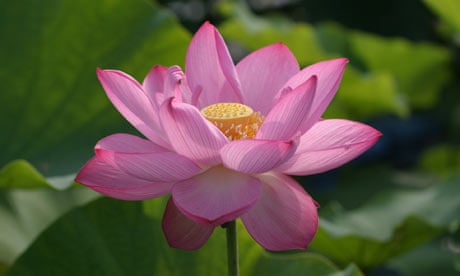Some years ago, a friend in Tokyo sent me three seeds of the lotus flower, Nelumbo nucifera. Fearing that I would make too much of a fuss of them, she waited until after I had succeeded in germinating and flowering them before telling me their story. They had come from a lotus that sprouted from a 3,000-year-old seed found in a Jomon-era excavation in Japan. For me this revelation was the beginning of a quest. I set out to discover all I could about the world's most famous flower. What I found was a species that left other iconic plants such as the lily, rose and tulip standing. The lotus provides foodstuffs, medicines and natural chemicals (such as those that ensure the seed's astonishing longevity) which have long sustained indigenous peoples and now intrigue modern biologists. It furnished Hinduism, Buddhism and numerous extinct religions with symbols of the mother goddess and reincarnation and lessons in ideal conduct. Its flowers, fruit and foliage proliferated in some of the greatest religious artworks of all time.
Across Japan in the next few weeks, in lakes and tubs, ponds and paddyfields, the massive buds of the lotus flower will open in the dawn. From Ueno Park in downtown Tokyo to the remotest rural fastness, lotus-viewing festivals will take place, turning a flower show into a mass spectator sport during what is known as the Time of the Lotus. Already fixtures in the Japanese diet, lotus rhizomes and seeds will be devoured in even greater quantities than usual; rice wine will be poured onto the plate-like leaves and their hollow stalks stuck between the lips to act as metre-long drinking straws. Around the middle of the month, a vast harvest of flowers and leaves will bring the lotus into millions of homes where it will play an essential role in Obon, Japan's great annual celebration of the returning dead.
A century ago, enchanted by the plant's preternatural beauty and myriad classical and oriental connections, the British grew Nelumbo nucifera in conservatories; bought wallpaper, fabrics and objets d'art inspired by it from Liberty and other bazaars; devoured books and articles on the plant and its Japanese haunts. Our lotus craze came to an end with the Great War. This magical flower, which has touched so many civilizations and reconciled nature and culture, science and spirituality, disappeared from our gardens and consciousness. Yet Nelumbo is easy to grow in a tub filled two thirds with soil, one third with water, and we have conservatories and sunny terraces aplenty. It is time for a revival.
The Lotus Quest by Mark Griffiths is out today, published by Chatto & Windus

Comments (…)
Sign in or create your Guardian account to join the discussion